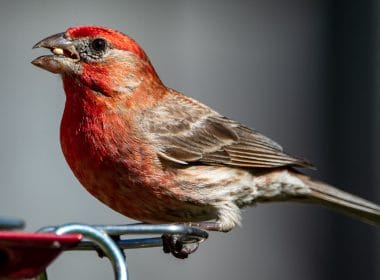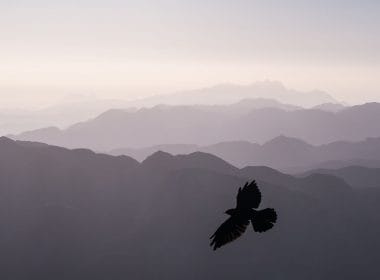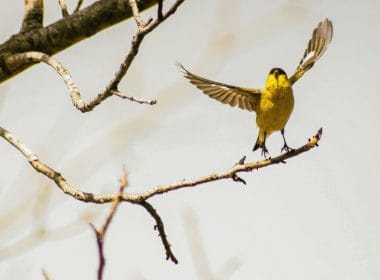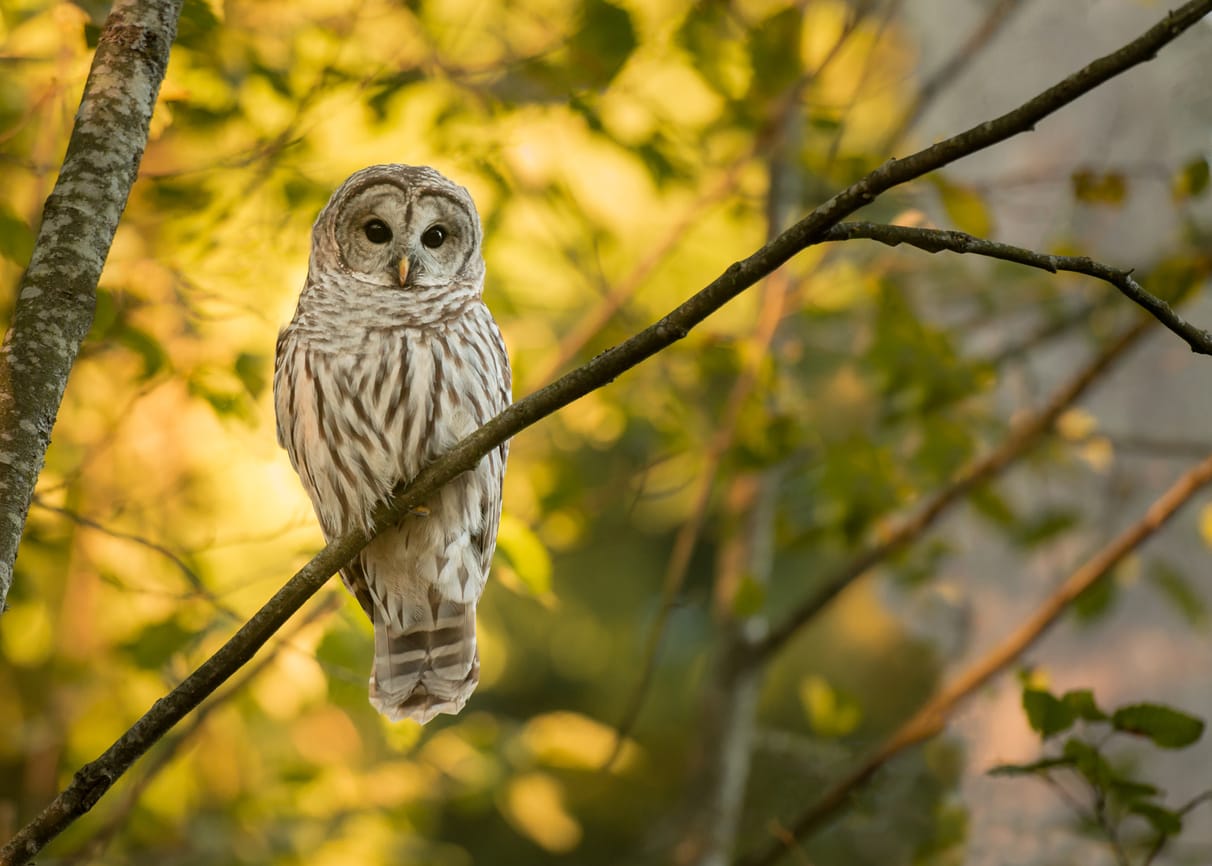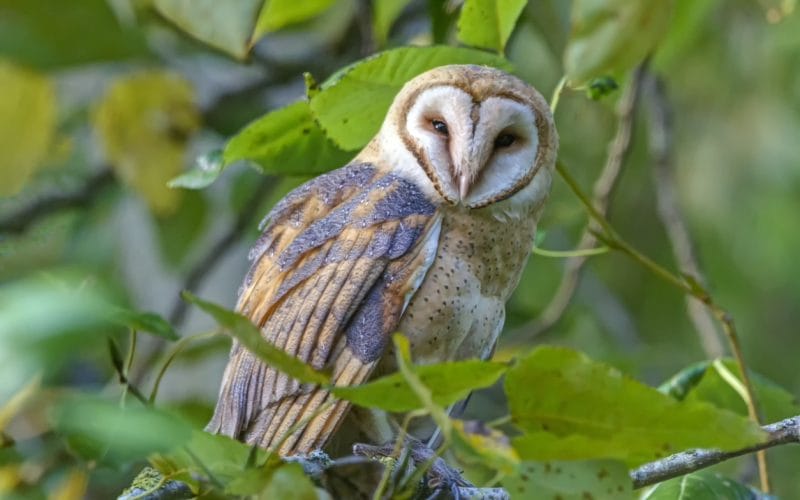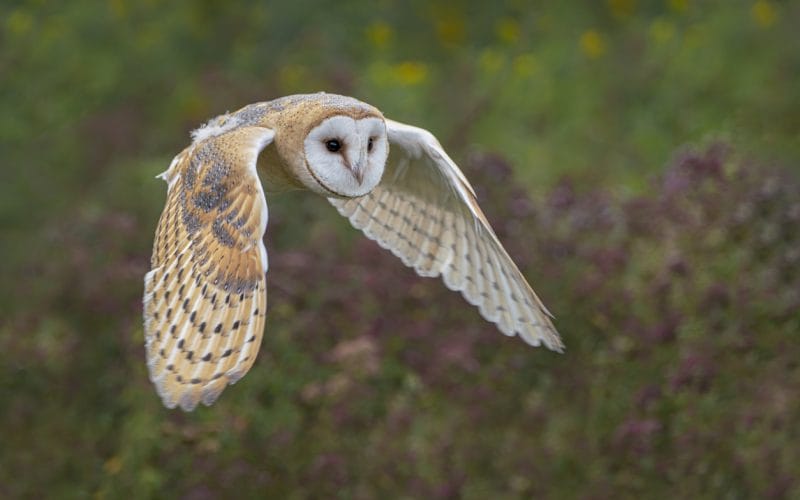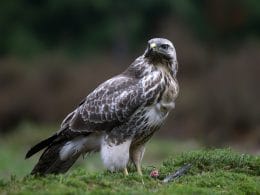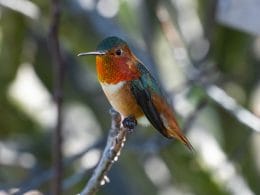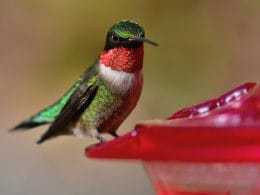New Hampshire is home to about 420 bird species, so it’s an excellent destination for every birdwatcher. It’s also home to many owls that have always fascinated birders for centuries.
Owls are different from other birds of prey because they’re usually roosting and sleeping during the day and hunt by night. However, some of them can be seen across New Hampshire during different times of the day.
If you’re fond of owls, you’ve come to the right place because, in this article, we’ll tell you all about them. So, keep on reading.
10 Owls in New Hampshire
New Hampshire is home to the highest Northeastern peak in Mount Washington and the shortest ocean coastline. It’s also the second most forested state in the US, and these diverse habitats attract different birds all year round, including owls.
Here is some valuable information about 10 owl species that live in New Hampshire.
1. Barred Owl

- Scientific name: Strix varia
- Length: Between 16 and 25 inches
- Weight: Between 16.6 and 37 ounces
- Wingspan: Between 38 and 49 inches
Additional Information
Unlike other states where the Great Horned Owl is the most common, the Barred Owl is more common in New Hampshire and can be found all across the state. It’s a nocturnal owl that prefers to nest in tree cavities, hunting at night.
Some birders are able to locate this bird by paying attention to its famous call, “Who cooks for you?”. As a matter of fact, some birders try to imitate this call to attract this owl to their location.
Author Note: It has a mottled brown and white body with some markings, and this plumage provides excellent camouflage, protecting it from larger predators like the Great Horned Owl.
This curious owl accepts human nesting boxes during the breeding season and feeds on rodents, birds, fish, amphibians, reptiles, and invertebrates, depending on where it’s nesting.
It’s usually attacked and mobbed by the American Crow, woodpeckers, and songbirds, while the nest is attacked by hawks and other larger birds of prey.
2. Northern Saw-Whet Owl

- Scientific name: Aegolius acadicus
- Length: Between 6.7 and 8.7 inches
- Weight: Between 1.9 and 5.3 ounces
- Wingspan: Between 16.5 and 22.2 inches
Additional Information
The Northern Saw-Whet Owl is quite common in New Hampshire, usually inhabiting the moist mature woodlands. It’s a tiny owl with a mottled brown body and bright yellow eyes.
Because it prefers to nest in densely wooded areas, this plumage provides an unbeatable camouflage that makes the owl quite difficult to spot.
This small owl hunts at night, usually feeding on voles, squirrels, mice, and chipmunks, attacking them from a perch. Due to its size, the owl usually feeds on its prey over two meals. It has asymmetrical ears, so the sound reaches both ears at two different times to accurately locate the prey in complete darkness.
This owl gets its name from its consecutive hoots, as some of them resemble the sound of the blade when it’s sharpened. Nevertheless, listening to the hoots might not help you locate it easily.
Instead, you need to keep an eye on songbirds and crows that usually mob this owl while it’s roosting and attack it to drive it away.
3. Great Horned Owl
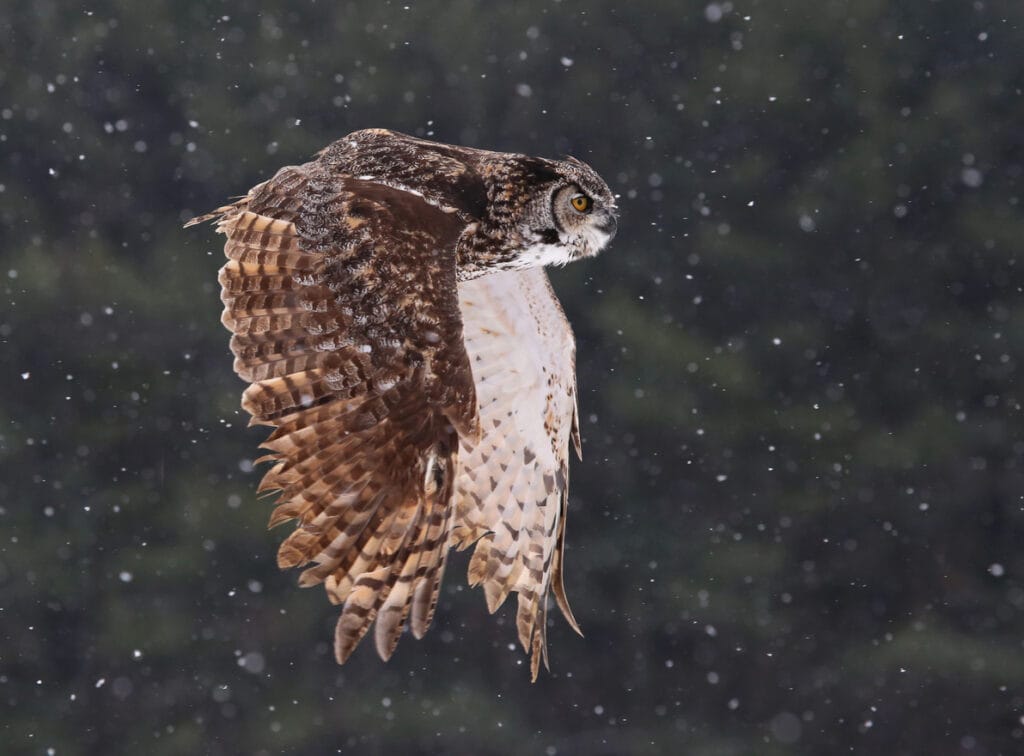
- Scientific name: Bubo virginianus
- Length: Between 17 and 25 inches
- Weight: Between 32 and 88 ounces
- Wingspan: Between 36 and 60 inches
Additional Information
The Great Horned Owl is one of the largest birds of prey in the US and can be found all year long in New Hampshire. This owl has a fearful look, thanks to its ear tufts that look like horns.
The owl has a gray-brown body and hunts at night, especially during the early hours at dusk and the late hours at dawn. It’s a highly adaptable owl and can be seen near residential areas and parks, although it prefers to nest in open grasslands.
The Great Horned Owl has a diverse diet and can eat everything, including mammals, fish, amphibians, reptiles, songbirds, invertebrates, and even other owls.
It’s also known to target prey that’s larger than its own body, severing the spine using its powerful claws with a grip that measures up to 28 pounds. This is the only owl that doesn’t mind feeding on skunks that other owls avoid because of their bad smell.
4. Northern Hawk Owl
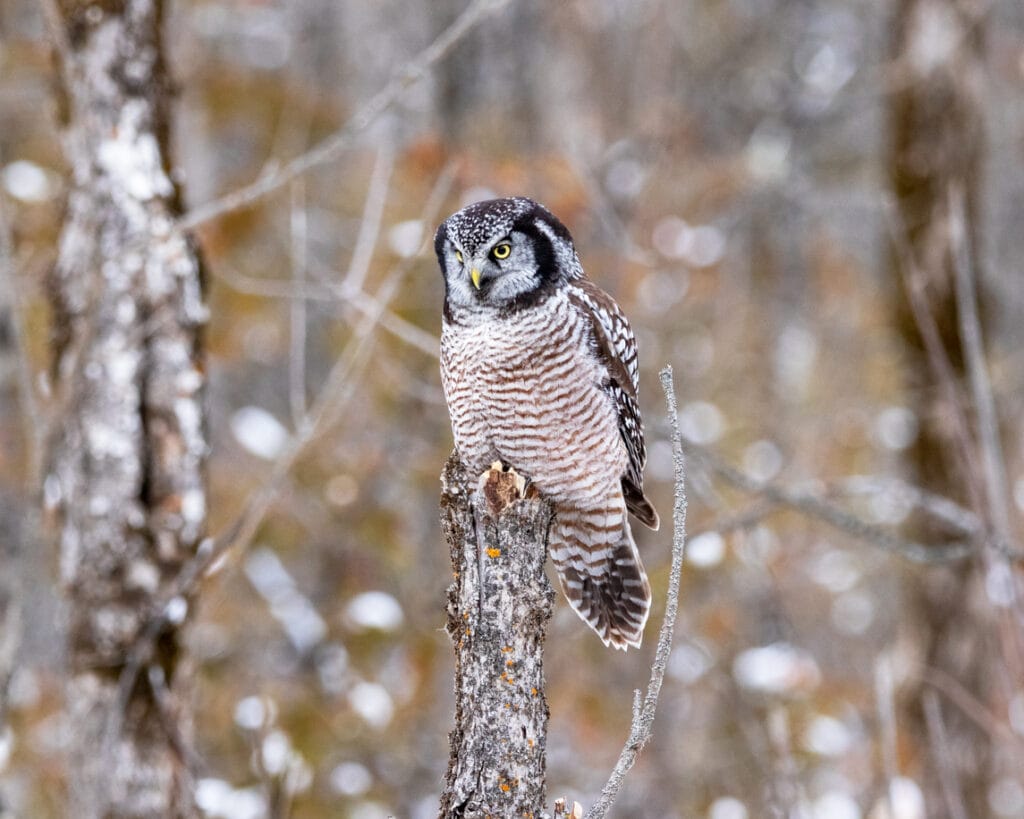
- Scientific name: Surnia ulula
- Length: Between 14.2 and 16.7 inches
- Weight: About 11 ounces
- Wingspan: About 18 inches
Additional Information
The Northern Hawk Owl is a true owl, but its hunting style resembles a hawk that hunts by day, although it sometimes hunts at night.
It can be found in the coniferous or mixed forests in New Hampshire, where the females nest on the top of trees or in tree cavities but don’t build their own nests. The owls also take over hollows excavated by woodpeckers.
Author Note: This owl is the same size as a crow and has an oval body with brown and white above and horizontal stripes on the underparts. The Northern Hawk Owl has a strong vision and usually perches, scanning the ground for the prey, which is able to detect up to 0.5 miles away.
Unlike other owls that rely on their hearing, this owl has symmetrical ears, so its hearing is less sensitive.
The Northern Hawk Owl prefers to feed on voles, but it can also feed on birds. This owl will hunt several small rodents when prey is abundant and store them in tree cavities.
5. Eastern Screech-Owl
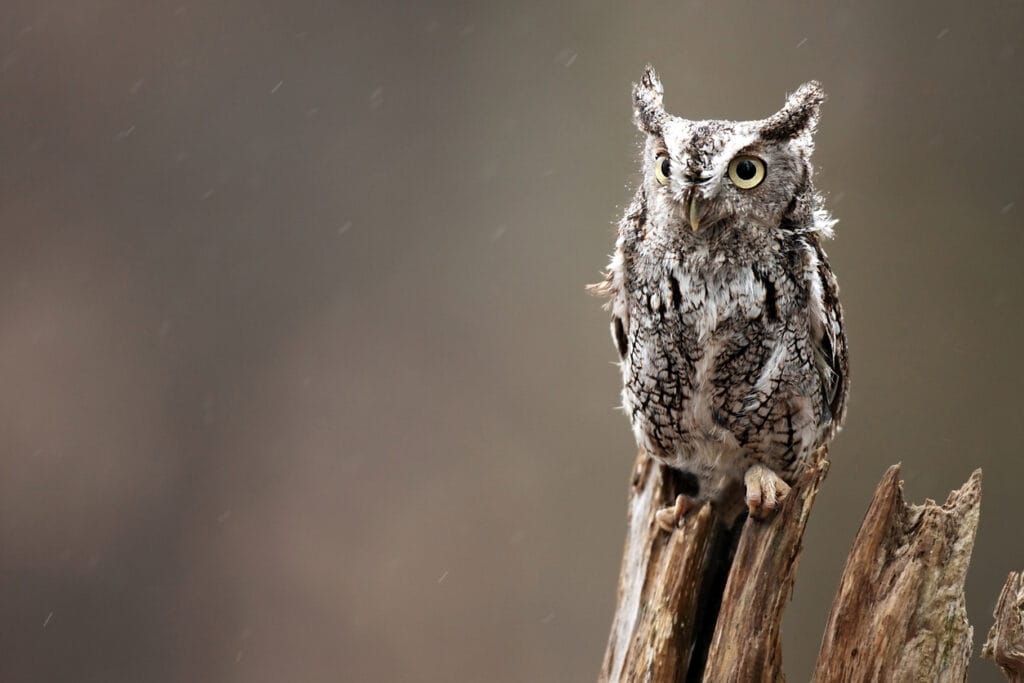
- Scientific name: Megascops asio
- Length: Between 6.3 and 9.8 inches
- Weight: Between 4.3 and 8.6 ounces
- Wingspan: Between 18 and 24 inches
Additional Information
Although the Eastern Screech-Owl prefers to live in open woodlands near fields and marshes, it’s also attracted to suburban areas where the prey is plentiful, and there aren’t a lot of predators. This owl will inhabit an area where there are mature trees to provide the perfect nesting and roosting sites.
Top Tip: The Eastern Screech-Owl is a stocky bird with a gray-red body that looks just like the bark, and it’s not intimidated by humans, so you might have a chance to get really close to it. It feeds on small mammals, reptiles, amphibians, large insects, and crayfish if it’s near water bodies.
Like most owls, the male owl is slightly smaller than the female, but it’s a better hunter. You can attract a breeding pair to your backyard by setting up a nest, but the songbirds nearby will try to flush the owls away.
6. Great Gray Owl
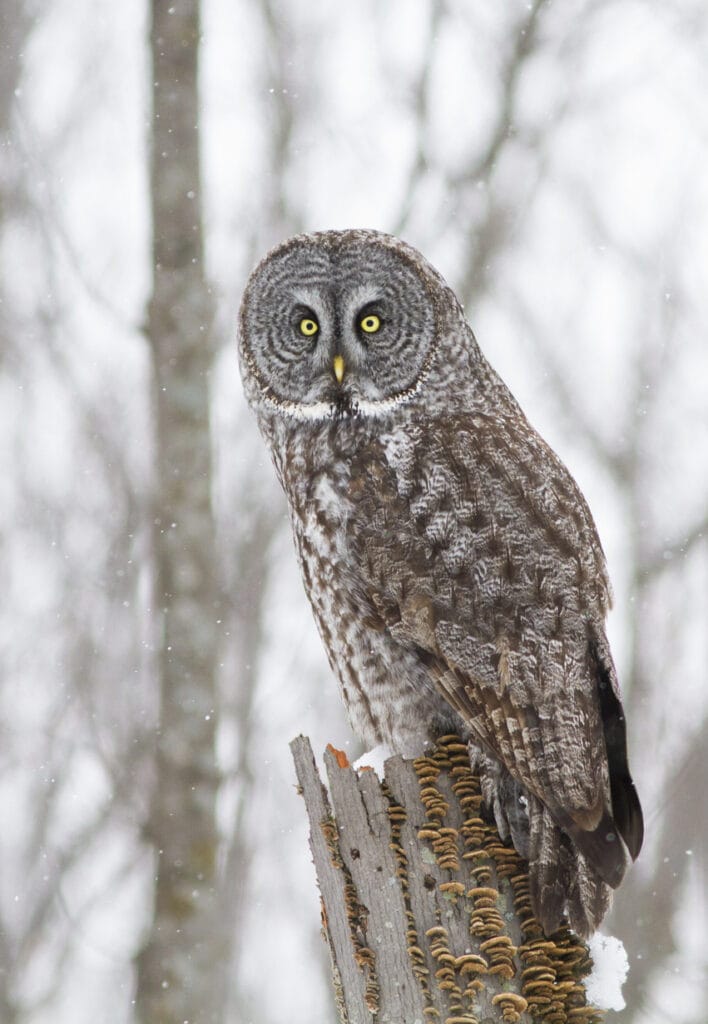
- Scientific name: Strix nebulosa
- Length: Between 24 and 33 inches
- Weight: Between 35.2 and 45.44 ounces
- Wingspan: About 60 inches
Additional Information
The Great Gray Owl is one of the tallest owls in the US and has a silver-gray plumage with some white feathers around the neck, resembling the look of a bowtie. Unlike other owl species, the male and female look similar.
Despite its size, this owl is rather challenging to find. It prefers to inhabit the small woodlands and the northern coniferous forests of New Hampshire near open wetlands and fields. It hunts at night and during the hours before dawn and dusk, usually flying low over the fields to catch its prey.
Your best chance to locate this owl is to inspect different levels of dead trees, as some birds prefer to perch low. It has strong talons that it uses to break through the snow, looking for its prey.
It prefers to feed on small mammals like voles, mice, moles, and lemmings, and its sensitive asymmetrical ears provide precise and directional hearing to find the prey even if it’s moving under the snow.
7. Boreal Owl
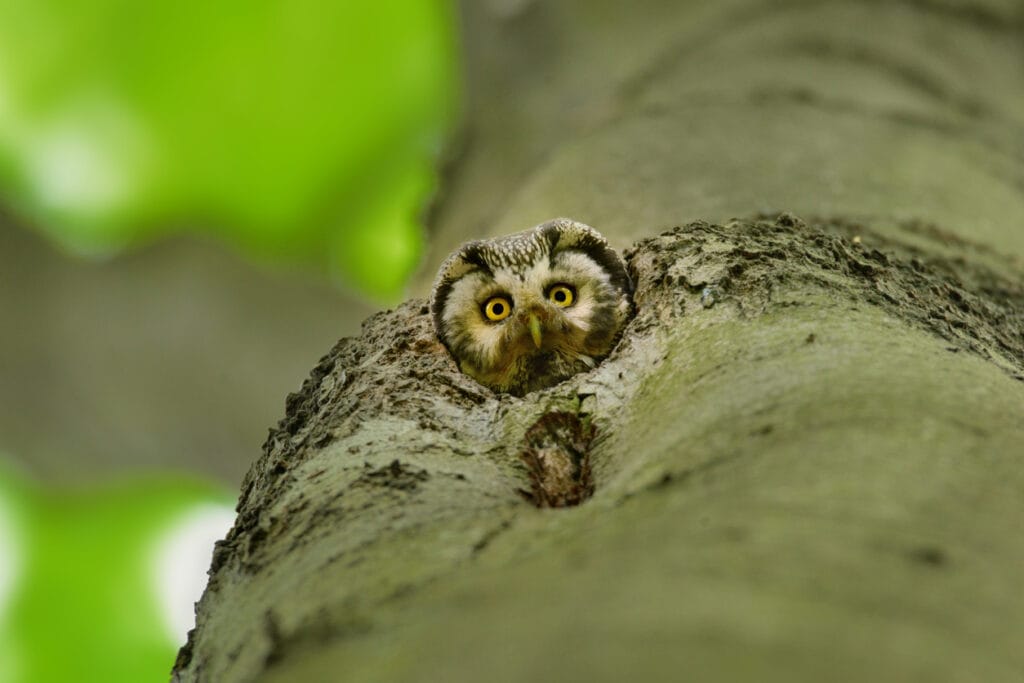
- Scientific name: Aegolius funereus
- Length: Between 8.7 and 10.6 inches
- Weight: Between 3.3 and 7.6 ounces
- Wingspan: Between 20 and 24 inches
Additional Information
The Boreal Owl gets its name from its habitat in boreal forests filled with spruce, fir, and aspen trees that grow at high latitudes where freezing temperatures occur between 6 and 8 months per year. It’s a small owl that has a square face, unlike owls that have round and oval faces.
Top Tip: It’s brown all over the body with some white spots and has bright yellow eyes.
This is not a common owl in New Hampshire, but you might be able to spot one in the colder months of winter.
However, it remains silent most of the time, so it’s not the easiest owl to spot. It hunts from a perch, mostly by night, and targets small mammals, but it might feed on birds and insects, coughing up pellets of the indigestible remains once a day.
Although in most owls the males are slightly smaller than the females, the difference is quite obvious in Boreal Owls, as the female owl can sometimes be twice as big as the male. In addition, the owls are solitary, even when they’re breeding, and pairs don’t remain monogamous.
8. Barn Owl

- Scientific name: Tyto alba
- Length: Between 13 and 15 inches
- Weight: Between 14.1 and 24.7 ounces
- Wingspan: Between 31 and 37 inches
Additional Information
Although Barn Owls can usually be found only in South-Eastern New Hampshire, it’s one of the easiest owls to identify, thanks to its distinctive plumage. It has a buff and gray body, dark eyes, and a heart-shaped face which gives her a scary look. Its call also sounds more like a scream, so it’s a bit irritating.
It’s a nocturnal hunter that can be seen hunting near open areas like meadows, fields, marshes, and pastures, especially with abandoned or large buildings and structures where this owl can find suitable nesting sites.
Female birds tend to have more spots on their bodies, and these spots can affect the female’s quality and life, as the more spots it has on its body, the more resistant it will be to parasites and infections.
A female with more spots is also more likely to attract the attention of a male, which will bring more food to the nestlings if the mother is spotted. The Barn Owl feeds on small mammals, especially mice, rats, bats, shrews, and rabbits.
9. Burrowing Owl
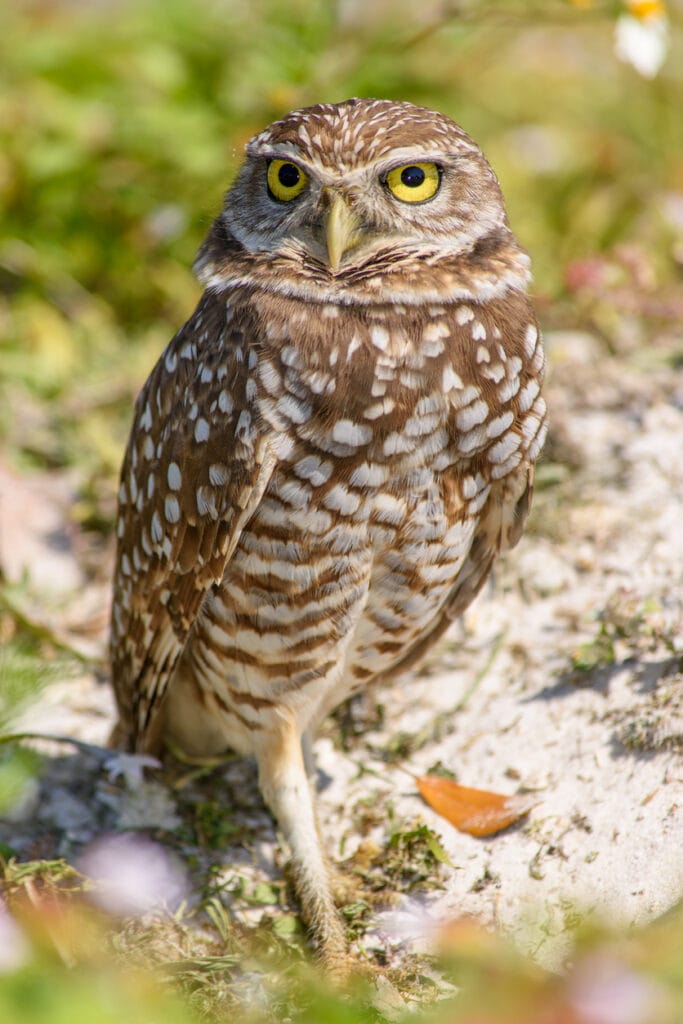
- Scientific name: Athene cunicularia
- Length: Between 7.5 and 11 inches
- Weight: Between 4.9 and 8.5 ounces
- Wingspan: Between 20 and 24 inches
Additional Information
The Burrowing Owl prefers to live in underground burrows, and both sexes are almost the same size, unlike most owls. It prefers to live in open areas, and its small size and perfectly camouflaged body make it challenging to find.
Although it’s quite rare to see, it’s a daytime hunter, so you might be able to spot it. The body is mottled brown and white with a sandy tan to resemble the owl’s habitat in the prairies.
Author Note: The Burrowing Owl prefers to live in burrows dug by prairie dogs, ground squirrels, and tortoises. But in the absence of burrows, it might nest in piles of PVC pipes.
This owl covers the burrow’s opening with animal dung to attract dung beetles to feed the nestlings. It also feeds on rodents, reptiles, and insects, sometimes storing thousands of rodents in the burrow.
10. Long-Eared Owl

- Scientific name: Asio otus
- Length: Between 12 and 16 inches
- Weight: Between 7.8 and 15.3 ounces
- Wingspan: Between 34 and 40 inches
Additional Information
The Long-Eared Owl can be found in the mixed forests near open fields and sparsely forested areas. It has a narrow face with long ear tufts, and its black-buff body makes it difficult to spot in the dense foliage where it prefers to roost all day. Its body is also equipped for silent flying.
Also known as the Cat Owl because of its look, this owl feeds on small mammals and birds that can be found feeding on the ground. It can be seen hovering over the area but will rarely hunt before night.
Unlike other owls that are highly territorial, this one prefers to roost in large groups. The male’s hoot can be heard up to 0.7 miles, and the owl usually kills its prey by a bite at the back of the head, and then it swallows it as a whole. After that, it coughs the fur, bones, and feathers in pellets.
Wrap Up
New Hampshire is a great place if you want to go hiking, kayaking, and sailing. But it’s also a great place to go birdwatching, especially if you’re interested in owls.
There are lots of owls that you can spot in New Hampshire during the day and night, so grab your binoculars because these birds of prey have excellent camouflage.
